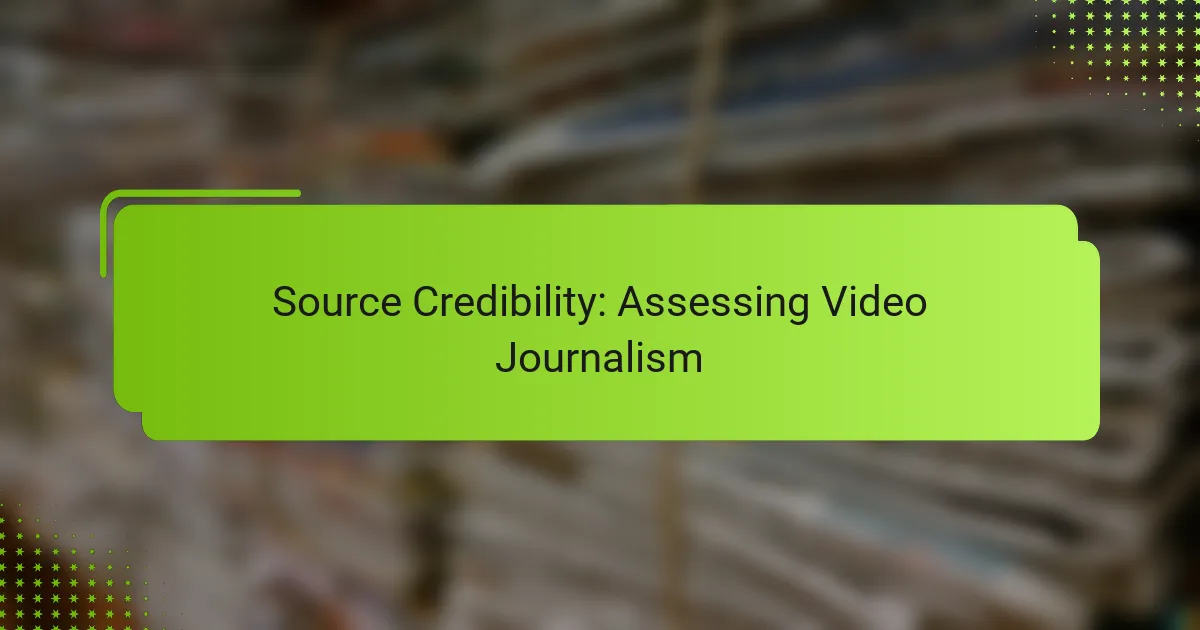Assessing source credibility in video journalism is essential for determining the trustworthiness and accuracy of the information presented. Key factors include the reliability of the content, the reputation of the source, and the transparency of the reporting process. By evaluating these elements, viewers can better discern the integrity of the journalism they consume.

How to evaluate source credibility in video journalism?
To evaluate source credibility in video journalism, consider the reliability of the information presented, the reputation of the source, and the transparency of the reporting process. Assessing these elements can help determine whether the content is trustworthy and accurate.
Fact-checking methods
Fact-checking is crucial for verifying the accuracy of claims made in video journalism. Reliable sources often utilize established fact-checking organizations or methodologies to confirm information before publication. Look for videos that reference these checks or provide sources for their claims.
Common fact-checking methods include cross-verifying statistics, checking dates, and confirming quotes. Tools like Snopes or FactCheck.org can be useful for independent verification of controversial claims.
Expert reviews
Expert reviews involve assessments from professionals in the relevant field who can evaluate the content’s accuracy and context. Videos that feature insights from recognized experts often carry more credibility, especially if these experts are affiliated with reputable institutions.
When evaluating expert reviews, consider the expert’s qualifications, experience, and potential biases. Look for reviews that provide clear reasoning and evidence to support their evaluations.
Cross-referencing sources
Cross-referencing involves comparing the information presented in a video with other credible sources. This method helps to identify inconsistencies and validate the reported facts. Look for videos that cite multiple sources or provide links to additional reading materials.
To effectively cross-reference, check for consistency in key details such as statistics, timelines, and quotes across different platforms. Reliable journalism often corroborates information from various reputable outlets, enhancing its credibility.

What are the key indicators of credible video journalism?
Key indicators of credible video journalism include transparency of sources, production quality, and journalistic integrity. Evaluating these aspects helps viewers discern the reliability and trustworthiness of the content presented.
Transparency of sources
Transparency of sources is crucial for establishing credibility in video journalism. This involves clearly identifying the sources of information, whether they are experts, eyewitnesses, or documents. When sources are cited, viewers can verify claims and assess the reliability of the information presented.
Look for videos that provide direct links or references to original documents and interviews. A credible video will often display the names and qualifications of experts, as well as the context in which information was gathered. This transparency fosters trust and allows viewers to make informed judgments.
Production quality
Production quality significantly impacts the perceived credibility of video journalism. High-quality visuals, clear audio, and professional editing suggest a commitment to accuracy and detail. Poor production quality, on the other hand, can raise doubts about the content’s reliability.
Consider the technical aspects such as resolution, sound clarity, and overall presentation. Videos that are well-lit, have stable camera work, and are free from distracting errors are more likely to be taken seriously. A good rule of thumb is to assess whether the production values match the seriousness of the topic being covered.
Journalistic integrity
Journalistic integrity refers to the ethical standards and principles that guide video journalism. This includes fairness, objectivity, and a commitment to truth. Credible video journalism should strive to present multiple viewpoints and avoid sensationalism.
Check if the video provides balanced coverage of issues, acknowledges biases, and corrects errors when they occur. Videos that adhere to established journalistic standards, such as those set by organizations like the Society of Professional Journalists, are more likely to be credible. Look for signs of accountability, such as corrections or follow-up reports, as indicators of integrity.

How does audience perception affect source credibility?
Audience perception significantly influences source credibility by shaping how viewers evaluate the reliability of video journalism. Factors such as trust in media outlets, the impact of social media, and viewer demographics play crucial roles in determining whether an audience considers a source credible or not.
Trust in media outlets
Trust in media outlets is foundational for audience perception of credibility. Established outlets with a long history of accurate reporting often enjoy higher trust levels compared to newer or less-known sources. For instance, traditional news organizations like BBC or CNN may be perceived as more credible than independent YouTube channels.
To enhance trust, media outlets should prioritize transparency, fact-checking, and ethical journalism practices. Regularly disclosing sources and corrections can also bolster credibility among viewers.
Impact of social media
Social media has transformed how audiences perceive source credibility by enabling rapid information sharing. Platforms like Twitter and Facebook can amplify both credible news and misinformation, often blurring the lines for viewers. As a result, audiences may struggle to discern trustworthy sources from unreliable ones.
To navigate this landscape, viewers should critically evaluate the origins of information shared on social media. Checking for corroboration from established news outlets can help mitigate the risks of misinformation.
Viewer demographics
Viewer demographics, including age, education level, and cultural background, significantly affect perceptions of source credibility. Younger audiences may favor digital platforms and influencers, while older viewers might trust traditional news sources more. This generational divide can lead to differing assessments of what constitutes credible journalism.
Media producers should consider these demographic factors when crafting content. Tailoring messages to resonate with specific audience segments can enhance perceived credibility and engagement.

What frameworks can guide the assessment of video journalism?
To effectively assess video journalism, frameworks such as the CRAAP test and the SPJ Code of Ethics provide structured criteria. These frameworks help evaluate the credibility, reliability, and ethical standards of video content.
CRAAP test
The CRAAP test evaluates the credibility of sources based on Currency, Relevance, Authority, Accuracy, and Purpose. Each criterion helps determine whether a video is trustworthy and suitable for use in research or reporting.
For example, consider the Currency aspect: a video covering current events should be recent, ideally produced within the last few days or weeks. Relevance assesses how well the content meets the viewer’s needs, while Authority checks the creator’s credentials and expertise in the subject matter.
When applying the CRAAP test, ask questions like: Is the information up-to-date? Does the creator have a background in journalism or the topic discussed? This approach helps ensure that the video journalism you consume is credible and reliable.
SPJ Code of Ethics
The SPJ Code of Ethics outlines principles for ethical journalism, emphasizing the importance of truthfulness, accuracy, and fairness. This code serves as a guide for video journalists to maintain integrity and accountability in their work.
Key tenets include seeking the truth and reporting it, minimizing harm, and acting independently. For instance, a video journalist should verify facts before broadcasting and avoid sensationalism that could mislead viewers.
By adhering to the SPJ Code of Ethics, video journalists can foster trust with their audience, ensuring that their reporting is not only accurate but also responsible and ethical. This commitment to ethical standards is crucial for maintaining credibility in the field of journalism.

What are the challenges in assessing video journalism credibility?
Assessing the credibility of video journalism involves navigating various challenges, including the manipulation of visuals and the rise of deepfakes. These factors complicate the evaluation process, making it essential for viewers to critically analyze the content they consume.
Manipulation of visuals
Visual manipulation can significantly distort the message of video journalism. Techniques such as selective editing, misleading framing, or the use of stock footage can create a narrative that diverges from reality. For example, a video may show a protest scene that is edited to imply a larger movement than what actually occurred.
To assess the authenticity of visuals, viewers should look for inconsistencies in lighting, audio quality, and context. Checking the source of the footage and cross-referencing with reputable news outlets can help verify the information presented. Always consider whether the visuals support or contradict the accompanying narrative.
Deepfakes and misinformation
Deepfakes represent a growing challenge in video journalism, as they can convincingly alter reality by superimposing faces or voices onto existing footage. This technology can be used to create misleading content that appears genuine, making it difficult for viewers to discern fact from fiction. For instance, a deepfake might show a public figure saying something they never actually said.
To combat misinformation from deepfakes, it is crucial to utilize verification tools and platforms that specialize in identifying manipulated media. Viewers should be skeptical of sensational claims and seek out fact-checking resources. Engaging with multiple sources can provide a more comprehensive understanding of the story and help identify potential misinformation.

How do emerging technologies influence video journalism credibility?
Emerging technologies significantly impact the credibility of video journalism by enhancing content creation and verification processes. These advancements help journalists produce more reliable and authentic reports while also providing tools to verify sources and information effectively.
AI in content creation
AI tools are increasingly used in video journalism to automate editing, generate scripts, and even create deepfake content. While AI can streamline production and enhance storytelling, it also raises concerns about authenticity and misinformation. Journalists must ensure that AI-generated content is clearly labeled and does not mislead viewers.
For example, AI can analyze viewer preferences to tailor content, but it is crucial to maintain ethical standards and transparency. Journalists should regularly review AI outputs for accuracy and context to uphold credibility.
Blockchain for source verification
Blockchain technology offers a decentralized way to verify the authenticity of video content and its sources. By recording each step of the content creation process on an immutable ledger, journalists can provide viewers with a transparent history of the footage, enhancing trust. This technology is particularly useful in conflict zones where misinformation can spread rapidly.
Implementing blockchain requires collaboration with tech partners and an understanding of the technology’s complexities. Journalists should consider adopting blockchain solutions for critical reports to ensure the integrity of their sources and maintain audience confidence.

What are future trends in source credibility assessment for video journalism?
Future trends in source credibility assessment for video journalism will increasingly focus on technology-driven solutions, such as AI and blockchain, to verify content authenticity. As misinformation becomes more prevalent, journalists and consumers alike will rely on advanced tools to evaluate the reliability of video sources.
Increased Use of Artificial Intelligence
Artificial intelligence is set to play a significant role in assessing source credibility in video journalism. AI algorithms can analyze video content for signs of manipulation, such as deepfakes or altered audio, helping to determine the authenticity of the source. This technology can also evaluate the credibility of the publisher by analyzing historical data and patterns.
For example, AI tools can flag videos that have been shared widely but originate from questionable sources, allowing viewers to make informed decisions about the content they consume. As these technologies evolve, they will become more integrated into news platforms, providing real-time assessments of video credibility.
Blockchain for Verification
Blockchain technology offers a promising method for verifying the authenticity of video journalism. By creating an immutable record of the content’s origin and any modifications made, blockchain can help establish trust in the source. This decentralized approach ensures that viewers can trace the video back to its original creator, reducing the risk of misinformation.
News organizations may adopt blockchain to certify their video content, providing viewers with a transparent way to assess credibility. This could include timestamps, creator identities, and a history of edits, allowing consumers to verify the source before sharing or acting on the information.
Emphasis on Media Literacy
As the landscape of video journalism evolves, there will be a greater emphasis on media literacy among consumers. Educating the public on how to critically assess video sources will be essential in combating misinformation. This includes understanding the context of the video, recognizing potential biases, and knowing how to use verification tools effectively.
Workshops and online resources can help individuals develop skills to evaluate video credibility. For instance, teaching viewers to look for corroborating evidence from multiple reputable sources can enhance their ability to discern reliable information in an increasingly complex media environment.



